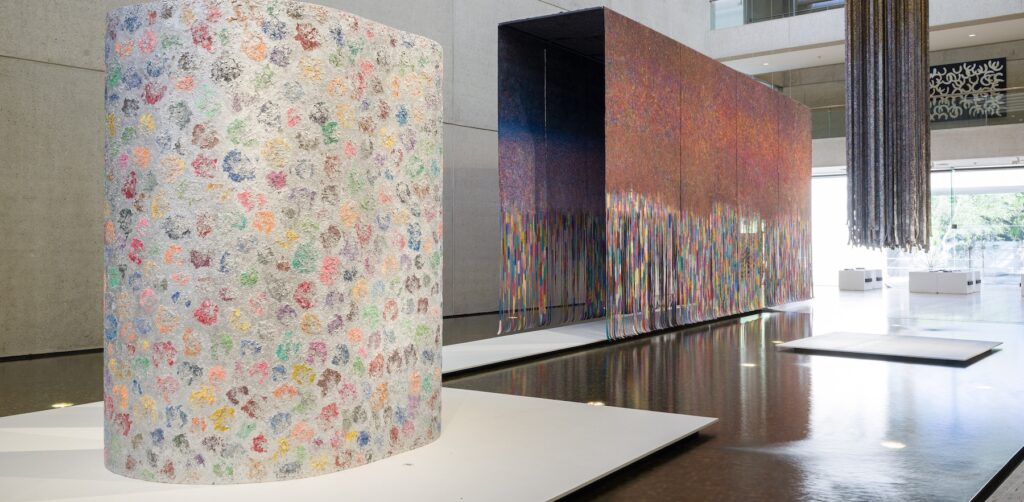
Earlier this year, Queensland Art Gallery’s neighbour, the Queensland Museum, opened a First Nations-led exhibition about Australian South Sea Islanders in Queensland.1 Say Our Name: Australian South Sea Islanders was staged in time for the thirtieth anniversary of national recognition for Australian South Sea Islanders, but also came amid sensitive negotiations behind the scenes regarding the repatriation of South Sea Islander ancestral objects and remains in the Museum collection.2 Part of the exhibition’s power comes from the juxtaposition of Museum artefacts with contemporary artworks by Australian South Sea Islander artists, all curated by Australian South Sea Islander historian Imelda Miller.
The artworks provide strikingly emotional visual expressions of the history of so-called ‘blackbirding’ and the displacement of adults and children from Papua New Guinea, Solomon Islands, Vanuatu, and surrounding lands; and with many works making reference to museological archives, the art effectively connected the present with a not-so-distant past represented in the artefacts. In a milieu where First Nations cultures have been failed by anthropological museums, which have historically presented items without permission, protocol, or the correct context, it does seem to me that contemporary art such as this is offering a future direction within the tall white walls of our institutions.

This summer, the 11th Asia Pacific Triennial of Contemporary Art at Queensland Art Gallery (QAG) and Gallery of Modern Art (GOMA) presents a similar blueprint for progress. Now in its eleventh iteration, the Triennial has for several years foregrounded First Nations-led models of art-making and curation. This year features a number of multi-artist projects that demonstrate sincere curatorial consultation with First Nations makers. Mindanao and the Sulu Archipelago: Roots and Currents is co-curated by Davao-born artist Abraham Ambo Garcia Jr, presenting indigenous and non-indigenous artists from the southernmost part of the Philippines. Nearby, Solomon Islander women’s group KAWAKI and their collaborator Dreamcast Theatre have woven mats as floor seating, and offer performance videos in a theatre set inside the gallery space. Artists for Waiapu Action (AWA) present, alongside a life-sized installation of a fish weir, photographic and video documentation of their activations of Māori aquacultural knowledge. The Torba Weavers of Gaua Island, Vanuatu, present fibre arts curated by Dely Roy Nalo. Yuriyal Eric Bridgeman, who has been visiting his mother’s homeland in the Jiwaka/Simbu highlands of Papua New Guinea for the past decade, brings the Haus Yuriyal kin-based collective to QAG. Haus Yuriyal presents a large body of work, including a raised meeting house, brilliantly coloured shield designs, and even a thriving vegetable garden.
This emphasis on history, origins, and cultural connections with land and waters is inherent to peoples across the Asia-Pacific, from as far west as Palestine, to as far north as Mongolia, and as close as Meanjin Brisbane. Meanjin-based Sancintya Mohini Simpson, Jasmine Togo-Brisby, and D Harding all bring their own powerful interpretations of colonial violence and cultural safety via their artworks. Harding’s woollen blankets in Woori Red (2024) are especially moving in their use of sheep’s wool, a coloniser fibre, which also absorbs and carries ochre from the artist’s Ghungalu Country at ‘Woori’ or Woorabinda in Central Queensland.

In keeping with the theme of origins and place, APT11 continues to provoke conversations about the perception of monoculturalism in Japanese artists. Albert Yonathan Setyawan, an Indonesian-born artist, developed his exquisite ceramics practice in Kyoto. China-born Japanese artist Ishu Han’s performative videos reference historic Chinese immigration across the seas. Haji Oh, of Korean-Japanese ancestry, now living in Australia, reproduces images of occupation, indenture, and immigration in Nauru—a tiny island nation subjected to 19th and 20th century colonial expansion that remains in the Australian consciousness as the site of an offshore ‘processing centre’ for asylum seekers. Okinawan artist Katsuko Ishigaki’s newly commissioned land- and seascapes capture the gorgeous greens and blues of the archipelago’s waters, as well as the uglier truth of the military infrastructure that fills the bays.
Amid the noise and events of the APT11 opening weekend, I completely missed one of the most subtle artworks of the exhibition, Melbourne artist Laresa Kosloff’s Public Announcements 3 (2024). Delivered through GOMA’s speaker system, the work is designed to sound like a generic visitor announcement—the kind one may or may not tune into as they move through the building. The artist’s words, which she describes as making her “cringe but laugh at the same time” (@laresa.kosloff, 7 December 2024) deliver advice and observations including: “If you find yourself in sour company, suggest an ice-cream or treat;” “People are seldom aware of the real reasons that motivate their actions;” and “Visitors are asked to leave a gap between complimenting someone and asking for a favour.” This subtle aural presence, in addition to a few other small sensory moments, including Tully Arnot’s tiny bird whistles perched above visitors’ heads and the heavy waft of oil paint emitting from Mit Jai Inn’s large paintings in the QAG Watermall, gently remind visitors that the APT offers a range of innovative contemporary art experiences that reward those who are attentive and open-minded to what is there, rather than what is expected to be there.
This review was kindly Guest Edited by Australian arts and music journalist Barnaby Smith.
- “Say Our Name: Australian South Sea Islanders,” Queensland Museum. Accessed 15 December 2024. ↩︎
- “Say Our Name: Australian South Sea Islanders,” Queensland Museum. ↩︎
Emily Wakeling is an art writer and curator specialising in Japanese and Australian contemporary art. She is Curator of Rockhampton Museum of Art, Darumbal Country.



